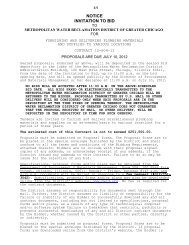Budget Message / Highlights - Metropolitan Water Reclamation ...
Budget Message / Highlights - Metropolitan Water Reclamation ...
Budget Message / Highlights - Metropolitan Water Reclamation ...
You also want an ePaper? Increase the reach of your titles
YUMPU automatically turns print PDFs into web optimized ePapers that Google loves.
METROPOLITAN WATER RECLAMATION DISTRICT OF GREATER CHICAGO<br />
2009 BUDGET<br />
<strong>Budget</strong> <strong>Message</strong> / <strong>Highlights</strong><br />
of the turbines, and renegotiated rates for the purchase of our electricity by ComEd has resulted in a projected increase for 2009<br />
revenue. The estimated electrical generation is 45 million KWHs with an anticipated revenue value of $2.1 million.<br />
Staffing<br />
District policy is to reduce staffing only by attrition. Current trends project the retirement of approximately 70-80 employees<br />
annually. The projected retirement level fits in well with the appropriation control (AC) program. The reallocation of personnel<br />
in certain job titles planned for attrition, based on completion of a specified project, to another title at a different location has<br />
worked very well since the beginning of this effort with the 1996 budget.<br />
District staff size and composition has for over two decades been managed through use of our “crosshatch program.” A “#1”<br />
following a position in the <strong>Budget</strong> indicates that the position, when vacated, will be dropped immediately. An “(AC)”<br />
following a position indicates that it is an appropriation control position identified for attrition, based on completion of a capital<br />
project or the implementation of revised work programs. These “(AC)” positions are dropped upon the recommendation of the<br />
Department Head and approval of the Executive Director. A “#2” after a title, signifies that when the position is vacated, the<br />
person filling the vacancy will receive the title in the parentheses. It can also indicate that while a grade level for a class title<br />
has been lowered the incumbent in the position will be retained at the current grade level. This is indicated by a notation of the<br />
new grade level in parentheses following the title. A #4 after a title, signifies that while a class title has been assigned to the<br />
Technical, Administrative and Managerial (TAM) salary schedule, the incumbent in the position will be compensated under the<br />
previously assigned Professional and Managerial (PM) or General Service (GS) salary schedule. When the position is vacated,<br />
the person filling the vacancy by promotion or new appointment will be compensated under the TAM salary schedule.<br />
A total of 2,131 positions are budgeted for 2009, an increase of 22 positions from 2008. The District continues to budget<br />
positions within the controls adopted in 1995 to slow the growth of future salary appropriations to fit within restrictions on<br />
property taxes resulting from the Property Tax Extension Limitation Act. In 2009, 46 appropriation control (AC) positions are<br />
budgeted compared to 48 in 2008, and 11 crosshatch (#1) positions are budgeted as compared to 4 in 2008.<br />
Salary expenditures are the largest item in our operating budget, comprising slightly more than 50 percent of the Corporate<br />
Fund. It is impossible to match future appropriation requirements with restricted growth in property tax revenue without<br />
making plans to change the way we work. Efforts have been made since 1995 to reengineer many labor intensive functions and<br />
reallocate staff. Adjustments to the original appropriation control program will continue to be made. Reductions in staffing<br />
levels impact all areas of District operations: professional/managerial, clerical, operating, and building trade personnel.<br />
Employee Benefits, Civil Service Examinations, Training, and Collective Bargaining<br />
Human resource activities include the hiring, promotion, and transfer of employees; the development and administration of the<br />
examination process; directing the District’s Equal Employment Opportunity (EEO) Program and ensuring compliance with<br />
Federal and State employment laws; classification, compensation, and benefits administration; labor and employee relations<br />
activities; training and professional development programs; interaction with the District’s Civil Service Board; and<br />
maintenance of employment records related to employees and budgeted positions.<br />
The Human Resources Department schedules approximately 50 Civil Service examinations annually. Roughly 40 percent of<br />
the District’s employees are represented by unions under collective bargaining agreements. There are 15 different unions<br />
representing District employees in six different bargaining units. Three-year successor agreements were negotiated with all<br />
bargaining units in 2008.<br />
Information Technology<br />
The 2009 appropriation request for the Information Technology Department is $21.0 million, a decrease of 4.1 percent,<br />
compared to the 2008 <strong>Budget</strong>. The appropriation is expected to remain fairly level over the next four years in order to execute<br />
the Information Technology Strategic Plan (ITSP). The District uses SAP R/3 software for its Enterprise Financial System<br />
which was originally implemented in 2000 and was the first successful public sector implementation of multiple business<br />
function modules in the State of Illinois. It was upgraded to the current version in 2004 and provides an integrated business<br />
system with financial, human resources, and purchasing applications in a common database.<br />
The Information Technology Department is responsible for refining and maintaining a District-wide Information Technology<br />
Strategic Plan; planning and program management services; design and implementation services; applications development and<br />
support services; infrastructure operations and maintenance services; user support services, including Help Desk services;<br />
maintaining and operating the District-wide wide-area and local-area computer networks; security and Disaster Recovery<br />
Services; promoting sustainable development and performance management by enhancing access and integration information,<br />
28<br />
28
















